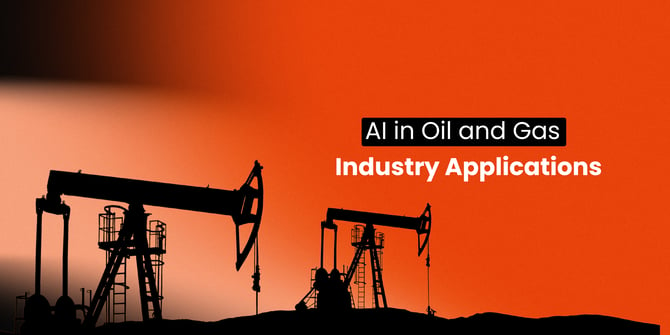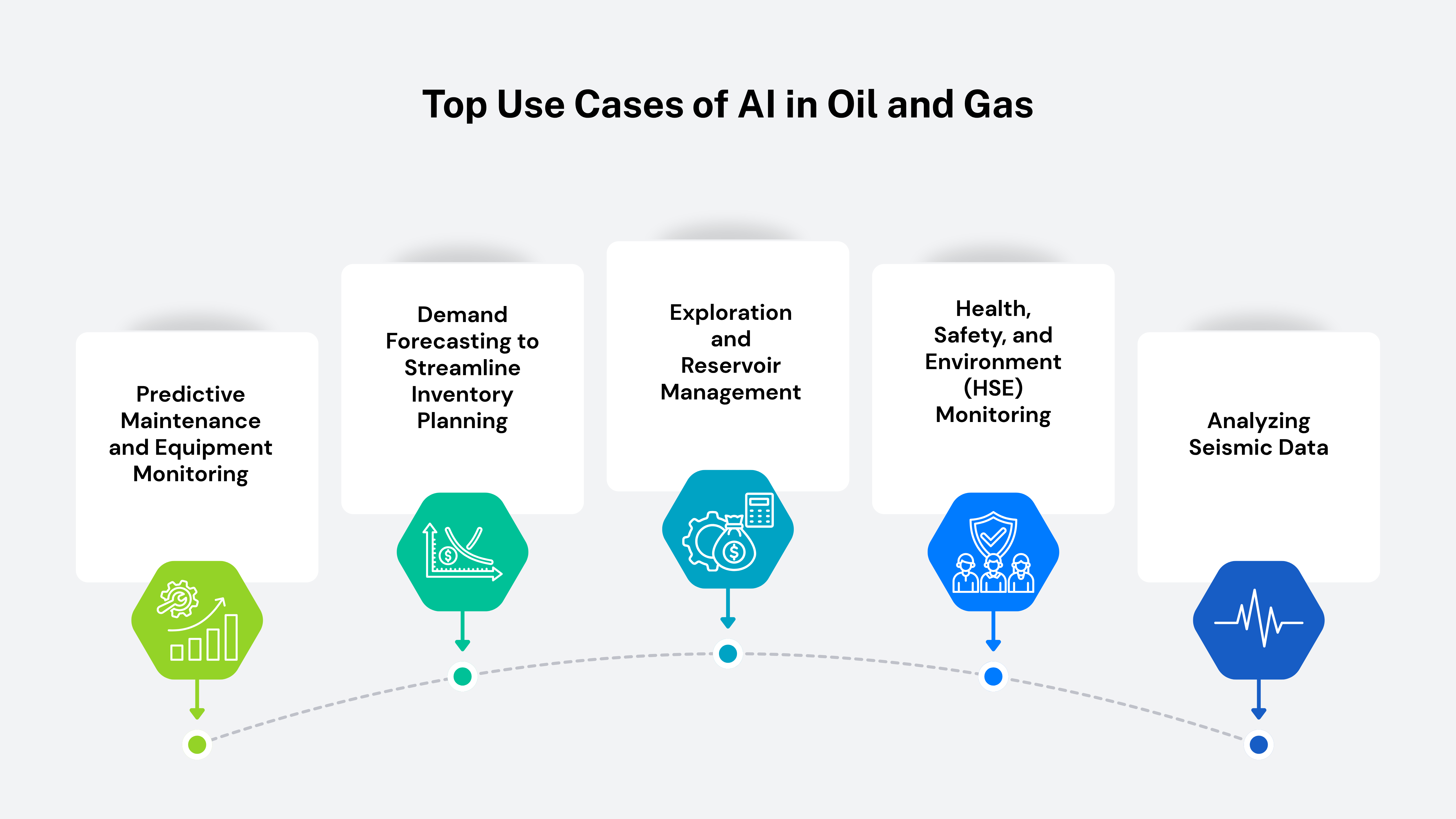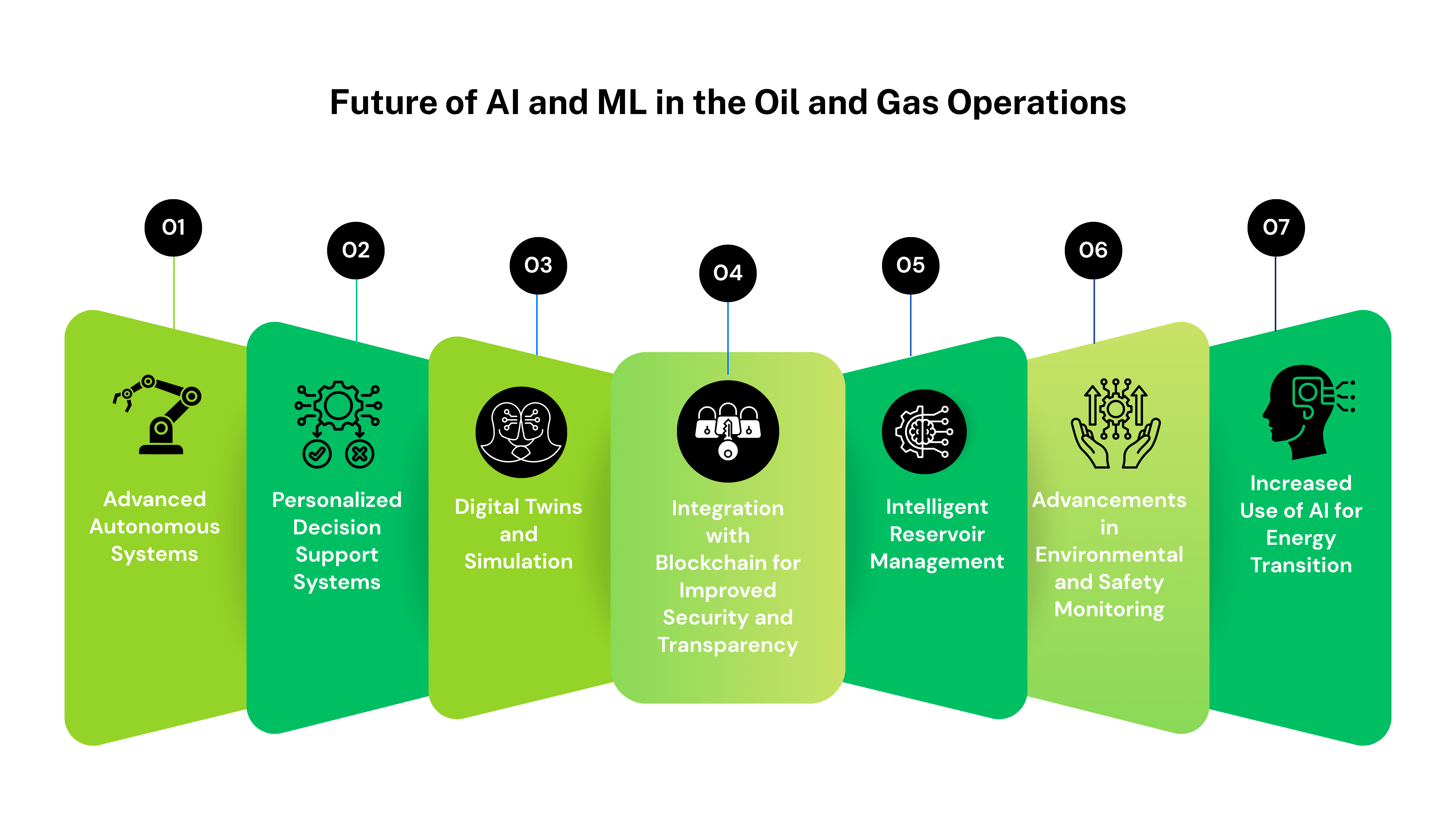Transforming Efficiency: AI in Oil and Gas Industry Applications
AI is changing how the oil and gas industry works and driving digital transformation. It helps companies maintain equipment, improve drilling, manage supply chains better, and monitor safety. This use of AI helps companies save money, improve their performance, and stay competitive.

ADNOC, a leading oil and gas company, recently reported generating US$500 million from AI solutions through its digital partnerships. For an industry often seen as slow to change, this figure is impressive and serves as a wake-up call.
The oil and gas industry today collects extensive data, including seismic readings, equipment logs, production histories, and supply-chain information. However, many companies still treat this valuable data like garbage instead of using it wisely. Meanwhile, the global market for artificial intelligence in oil and gas is expected to grow quickly. It is projected to reach USD 6.4 billion by 2030.
As a business leader, using AI is not just about having a new tool; it helps you gain a competitive advantage, compete better, reduce unexpected downtime, control costs, and meet strict ESG and regulatory requirements. Businesses using AI solutions in the oil and gas industry are already experiencing the benefits.
In this post, we will look at how AI is impacting the oil and gas industry, its use cases, and the technology's future possibilities.
Let us get started.
 Generate
Key Takeaways
Generating...
Generate
Key Takeaways
Generating...

-
AI is creating value for companies by improving operations from exploration to refining. It enhances accuracy, productivity, and decision-making while reducing human error and risks.
-
Predictive maintenance is at the forefront of AI use, as real-time monitoring of equipment helps prevent breakdowns, cut downtime, and save millions on maintenance.
-
Digital twins and automation improve asset management by offering real-time visibility, better forecasts, and smooth coordination across complex oil and gas systems.
-
Generative AI encourages innovation by helping to create smarter exploration models, simulate refinery operations, and optimize production using data-driven strategies.
-
Companies that want to be ready for the future are adopting AI now. Working with an experienced AI development company ensures tailored, scalable solutions that provide clear returns on investment and support energy transition goals.
Top Use Cases of AI in Oil and Gas
Generative AI can enhance any data, making it easier to inform decisions. This technology can streamline lengthy processes into a single question and help workers discover new knowledge and skills. Given this potential, there are many exciting and valuable ways to use generative AI in industries like mining, oil and gas, chemicals, agriculture, power, and materials. Leaders in these fields should consider adopting AI.
The oil and gas industry, which has focused on operational costs, supply, and demand, stands ready to gain from AI technology. Here are some of the top AI use cases in the oil and gas industry.

1. Predictive Maintenance and Equipment Monitoring
Predictive maintenance is becoming increasingly important in the oil and gas industry. Machine learning models can predict when equipment might fail or require maintenance by analyzing sensor data from the machinery, ensuring high data quality. These AI systems help companies spot potential problems before equipment failures occur. This early detection can prevent costly downtime and repair fees.
For example, AI can monitor vibration patterns, temperature changes, and other important data to detect mechanical problems early. This helps equipment last longer, lowers repair costs, and reduces downtime.
Instead of doing regular maintenance on machines, new data sensors use artificial intelligence and machine learning to check how well equipment is working and to predict when it needs maintenance.
This approach, called predictive maintenance, can help avoid machine breakdowns, reduce downtime, improves efficiency and make equipment last longer. It also cuts down on unnecessary maintenance, saves money, and keeps operations running smoothly.
Unplanned Downtime Costs Oil and Gas Companies up to $38 Million a Year
AI-powered predictive maintenance can help you detect issues early, extend equipment life, and save millions in operational losses.
2. Demand Forecasting to Streamline Inventory Planning
One major challenge oil and gas executives face is predicting demand accurately based on evolving market conditions. AI algorithms analyze a lot of data, including global market trends and sales data, to assess current oil supplies and improve demand forecasting in the short, mid, and long term.
With this information, oil and gas companies can adjust their production levels. They can decide to maintain, increase, or decrease production based on the forecasts. This helps them anticipate the demand for offshore drilling and more oil exploration.
3. AI Helps to Make Oil and Gas Supply Chains More Robust
Earlier, the oil and gas industry, like many others, aimed to make supply chains affordable. However, problems in global supply chains led to major disruptions in everyday life. This pushed many companies to rethink how they import and export oil. Four years later, AI workflow integration has greatly changed how companies handle supply chain logistics and management.
For example, AI helps automate shipping and traffic routes based on ocean currents and weather, utilizing advanced analytics. It finds the best suppliers based on what is needed. AI also improves a company’s ability to track tankers, pipelines, and trucks transporting oil, allowing for quick responses to delays or problems.
AI algorithms can predict how unexpected political, economic, or natural events might affect imports, exports, and inventory levels.
4. Reduce Well/Equipment Downtime
Unplanned downtime costs oil and gas platforms millions of dollars each day during a catastrophic failure. One of the largest oil and gas companies used AI to predict well collapses better before they occur. This helped them maintain equipment, operate wells more efficiently, and extend their lifespan.
To achieve this, plant engineers created a traffic-light system that warned them of the risk of a well collapse. This system allowed them to reduce downtime effectively. By using AI tools, the plant was able to cut well recovery time by 83 percent and save $20,000 in replacement fuel costs per well each day.
5. Asset Tracking and Maintenance using Digital Twins
Managing assets in oil and gas, including their monitoring and upkeep, project planning, and lifecycle management, is very important. Digital twin technology can significantly help in this area. It allows oil and gas companies to address issues like production imbalances and the reliability of equipment, especially during fast-changing global economic conditions. To operate effectively in these busy, sometimes chaotic times, oil and gas companies need systems that provide real-time visibility and flexibility, which digital twins can offer.
90% of Oil and Gas data goes unused that’s untapped potential sitting in your Systems
Transform your operational data into predictive insights and profit-driving intelligence with tailored AI solutions.
6. Exploration and Reservoir Management
AI is changing how we find oil and gas and optimize gas operations by analyzing large amounts of seismic and geological data. This helps identify potential reservoirs more accurately. Machine learning models can understand subsurface geology, which means we need less drilling and can make better decisions when locating resources. AI also improves reservoir management by predicting how fluids flow, increasing recovery rates, and extending the life of reservoirs.
7. Drilling Optimization
AI helps improve drilling operations by analyzing real-time data. It focuses on factors like pressure, temperature, and rock properties to make better drilling decisions. This helps to reduce risks, speed up drilling, and lower costs through the use of ai applications. In challenging drilling situations, AI can predict problems and enhance overall well performance.
8. Health, Safety, and Environment (HSE) Monitoring
AI improves safety in the oil and gas industry by monitoring real-time data from field operations, equipment, and workers. AI systems can detect potential dangers such as gas leaks, equipment failures, or unsafe working conditions. This helps companies take preventive safety actions.
AI also helps track compliance with environmental regulations by analyzing emissions and waste-management data, while improving sustainability efforts.
9. Autonomous Inspection and Monitoring in Oil and Gas
AI-powered drones and robots are being used more often to inspect and monitor oil and gas infrastructure, like pipelines, offshore platforms, and refineries. These smart systems can quickly find leaks, corrosion, and other problems in structures. This reduces the need for people to work in dangerous areas, which improves safety. It also speeds up inspections and lowers operating costs.
10. Contract Risk and Compliance Automation
Regulatory compliance is becoming more important, especially across different countries, as government agencies step up their oversight. An AI strategy in oil and gas can help by reviewing procurement and vendor contracts. It can point out outdated clauses, non-compliant terms, or risky conditions that may be hard to find in lengthy legal documents.
Instead of depending only on human reviews, which can be slow and prone to mistakes, AI acts as a compliance assistant. An effective ai strategy helps you avoid penalties, lawsuits, and operational risks.
11. Analyzing Seismic Data
Drilling is a key part of producing energy in the oil and gas industry. However, companies often face challenges due to factors like soil and subsurface properties. Shell is an example of an energy company using AI to analyze seismic data and conduct seismic surveys. This helps them find the best drilling targets and improve energy efficiency, such as in the Arctic.
12. Detecting Leaks
Pipeline leaks can cause significant harm to a company and the environment, leading to a negative environmental impact. They are the main cause of environmental damage on land from oil companies and can also lead to financial losses for these companies. Saudi Aramco is a petroleum refinery that uses AI to detect potential pipeline leaks. With predictive maintenance, they can fix these problems before they cause major damage and minimize environmental impact.
13. Catalyst Management
Refining catalysts are essential for getting valuable products from heavy oil, like crude oil. If the development of these catalysts slows down, it will hurt the productivity and efficiency of the entire operation. Therefore, it's crucial to create new catalysts on time.
Chevron, an energy company in the oil and gas industry, is using AI to improve how it develops these catalysts. Their program helps reduce emissions from their refineries and makes the refining process more efficient.
14. Modeling Reservoirs
Oil and gas companies primarily use reservoirs to store their finished products before shipping. Managing and designing these reservoirs is a crucial step that companies have focused on since they started, using various methods and technologies.
For instance, ExxonMobil, a natural gas company, is using AI in the oil and gas sector to improve its reservoirs, particularly in the Permian Basin. This technology helps them better understand their reservoirs and optimize production based on their future experience.
Chevron and Shell are already using AI to Refine Processes and Reduce Emissions
With AI-driven optimization, your refinery can achieve similar results like higher yields, cleaner operations, and reduced waste.
Benefits of Artificial Intelligence in Oil & Gas Industry
AI is changing the oil and gas industry by using data to make better decisions. It can predict when equipment will fail, which helps avoid problems. AI also improves drilling and refining processes, helping companies save money, increase safety, and produce more efficiently. Below are some of the top benefits that business leaders in the oil and gas industry are leveraging:
Improved Oil and Gas Exploration
AI helps with exploration by analyzing large amounts of seismic and geological data. Machine learning finds patterns that can lead to better and cheaper resource discovery. This means we can drill more efficiently and improve recovery rates.
Enhanced Operational Efficiency
AI optimizes operations by analyzing big data and automating tasks. This helps businesses use resources more efficiently, cut down on waste, and boost productivity. AI also simplifies workflows, giving clearer insights for decision-making and enhancing overall business performance.
Improved Workers Safety
AI improves safety by constantly monitoring equipment and environmental conditions for risks. Real-time data analysis helps identify hazards quickly, allowing for immediate action to fix them. This reduces accidents and creates a safer work environment for employees in high-risk areas.
Using robotics and computer vision for dangerous tasks in oil and gas significantly lowers the chances of accidents and does risk management. AI also helps maintain safety standards with up-to-date monitoring and surveillance.
Future of AI and ML in the Oil and Gas Operations
The future of AI and ML in the oil and gas industry is set to grow quickly in the coming years, leading to increased ai investments . This growth will be significant and will cover many important areas. AI is the most important technology today and is rapidly entering many industries. This creates new opportunities for innovation and growth. Here is an overview of potential future developments and their implications:

1. Advanced Autonomous Systems
With the growth of advanced AI and machine learning technologies, industries are ready to use more agentic AI systems. For example, self-driving drilling rigs, trucks, robotic inspection units, and drones that use AI to monitor and collect real-time data. These AI agents will reduce the need for human intervention in dangerous environments that will lead to improved operational accuracy, and lower costs.
2. Personalized Decision Support Systems
Advanced technologies will help businesses use AI-powered applications that provide personalized insights based on their specific needs. These AI models can gather data from different sources to give tailored recommendations, support planning, and improve decision-making. They will enable businesses to analyze complex situations and achieve better results.
3. Digital Twins and Simulation
Digital twins are virtual versions of real-world assets. With advancements in AI and machine learning, these digital twins will become more accurate and updated in real time. This will allow businesses to simulate them better, leading to improved forecasting, scenario analysis, and optimization. As a result, digital twins will help companies make better decisions and gain deeper insights into complex systems, ultimately improving asset management and performance.
4. Integration with Blockchain for Improved Security and Transparency
Combining artificial intelligence (AI) with blockchain technology can improve data security, transparency, and traceability in the oil and gas industry. Blockchain provides secure and unchangeable records of transactions and operations. AI can analyze this data to identify fraudulent activities or inefficiencies in the system. This integration will increase trust and improve processes within the supply chain.
5. Intelligent Reservoir Management
Using AI and machine learning will change how we manage reservoirs. These technologies will help us create better geological models and analyze data in real time. Future improvements will lead to more accurate reservoir modeling, better methods for enhancing oil recovery, and effective management of complex fields. This will help extend the life of oil and gas fields, get the most resources out, and make the best use of our investments.
6. Advancements in Environmental and Safety Monitoring
As AI and machine learning improve, businesses will enhance how they monitor the environment and safety. Better algorithms will help companies analyze data from more types of sensors and sources. This will allow them to receive early warnings about environmental threats and safety risks. AI will also help businesses adopt best practices to reduce negative impacts on the environment and improve compliance within the value chain.
Worker Safety and Environmental Compliance Remain Top Risks for Global Energy Leaders
Use AI to monitor field data in real-time, detect safety hazards instantly, and ensure every operation meets ESG goals.
7. Increased Use of AI for Energy Transition
AI technology and digital solutions will be essential for the global transition to renewable energy sector. It will help develop and integrate cleaner energy sources. Integrating AI will optimize hybrid energy systems, improve energy storage solutions, and manage smart grids. This will support the move to cleaner energy while ensuring efficient and reliable energy production.
Bottom Line
Artificial intelligence is crucial for today’s operations. It helps with tasks like predicting when maintenance is needed to prevent costly shutdowns, optimizing drilling while it is happening, and improving energy forecasts. Leaders who benefit most from AI are the ones who include it in their key business decisions.
If you are still waiting for the “right time” to invest in AI, now is the time to act. Delaying your investment in ai applications makes it harder to keep up with competitors who use data to reduce costs, lower emissions, and increase efficiency.
Working with an experienced AI development company that specializes in big data analytics can help make this change easier and faster. Whether you need custom AI models, automation in your existing systems, or machine learning for predictive insights, the right tech partner can help you turn potential into performance.
Frequently Asked Questions
Have a question in mind? We are here to answer. If you don’t see your question here, drop us a line at our contact page.
What is the most common use of AI in oil and gas?
![]()
The oil and gas industry often uses AI for predictive maintenance. This technology analyzes sensor data from rigs, pipelines, and equipment to identify potential failures before they happen. By doing this, companies can prevent unexpected downtime, lower maintenance costs, and enhance safety.
Is AI adoption in the oil and gas industry expensive?
![]()
Implementing AI can be affordable. The cost mainly depends on how big, complex, and ready your current systems are. Many companies start small by automating one process, like equipment monitoring, and then expand as they see benefits. With the right AI development company, you can create solutions that fit your budget and provide clear returns on investment from the beginning.
How is AI being used in the oil and gas industry?
![]()
AI is used throughout the oil and gas industry, from finding new drilling sites to production and distribution. In exploration, AI looks at seismic data to spot drilling opportunities more quickly. In production, it improves drilling methods and predicts how well equipment will work. In refining and distribution, AI forecasts demand, manages logistics, and cuts down on energy waste. Overall, AI is making the industry smarter, safer, and more sustainable.
What is the best AI for oil and gas?
![]()
There isn't one type of AI that works for every company in the oil and gas sector. The right AI depends on your business goals and how well-developed your data is. Some companies benefit from machine learning models that help with predicting outcomes, while others find value in using AI for automation or digital twins. The key is to partner with an AI development company that understands your operations and can create tailored solutions that match your business needs.
What is Gen AI in the Oil and Gas Industry?
![]()
Generative AI (Gen AI) is transforming the oil and gas industry by providing new insights and solutions, rather than just automating tasks. For example, Gen AI can help create new exploration models, plan drilling strategies, or simulate how refineries work under different conditions. This technology allows leaders to make quicker, data-driven decisions and encourages innovation throughout the industry.


%201-1.webp)


.png?width=344&height=101&name=Mask%20group%20(5).png)






.png?width=352&name=How%20AI%20is%20Transforming%20the%20Telecom%20Industry%20(1).png)









